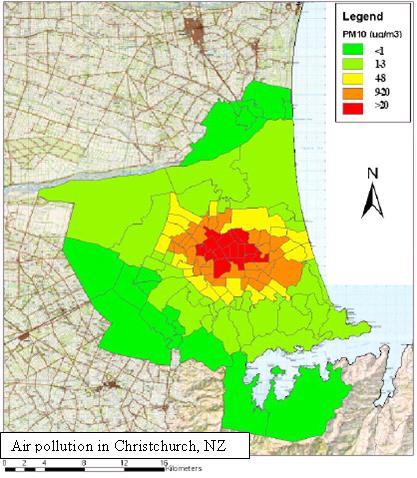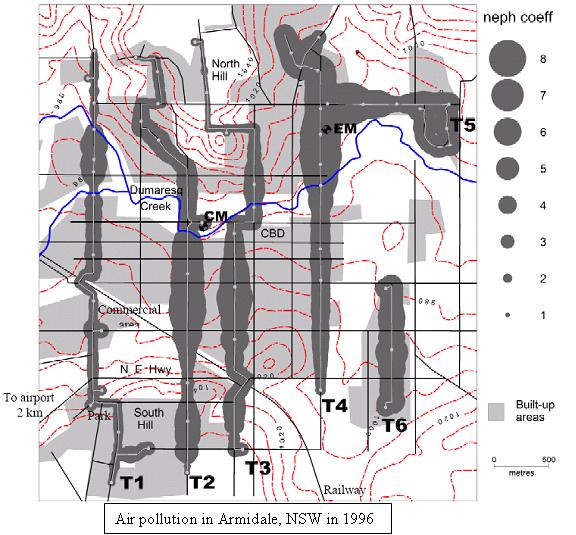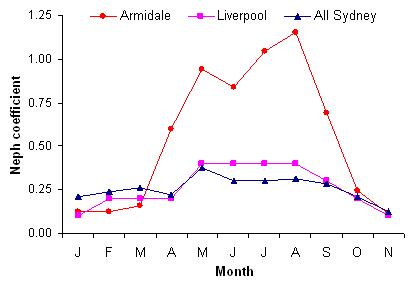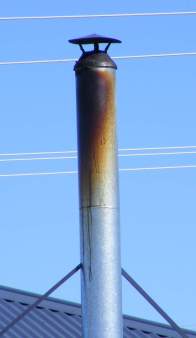Contents
Spatial variation in smoke pollution & death rates - Christchurch
Reducing pollution saves lives
Estimated health costs - thousands of dollars per woodheater per year
Spatial variation in smoke pollution - Armidale
Comparison of Armidale and Sydney
Recommendations

Christchurch: deaths up to 16% higher in woodsmoke polluted areas
Average PM10 pollution in Christchurch, NZ, varies from <1 µg/m3 on the undeveloped fringes of the city to >20 µg/m3 in residential areas with lots of chimneys (see map). More than three quarters (76%) of pollution is from woodsmoke, with only 13% from industry, 11.7% from diesel vehicles and 0.3% from petrol vehicles[1].
Up to 68% more respiratory deaths. New analyses published in 2007 show that (after adjusting for other factors such as age, sex, ethnicity, socio-economic status and tobacco smoking habits) death rates were related to smoke levels[2].
Estimates for each increase of 10µg/m3 of PM10 exposure were:
• 34% increase in respiratory deaths
• 11% increase in circulatory deaths
• 8% increase in all deaths
This implies that living in the most polluted areas (>20µg/m3 PM10) increases mortality by about 16% (respiratory deaths by about 68%) compared to living in unpolluted areas with <1 µg/m3. Chemical analysis shows that woodsmoke contains the same and similar compounds to tobacco smoke, so it is not surprising that we see the same health effects, including respiratory and cardiovascular diseases. Other studies have linked woodsmoke to mouth, throat and lung cancers and PM10 pollution in general to cot deaths[3 4]. Woodsmoke contains significant quantities of polycyclic aromatic hydrocarbons (PAH). PAH from air pollution have been linked to genetic damage in babies[5].
Reducing pollution saves lives
When cities reduce their pollution, death rates fall. In 1990, Dublin reduced PM pollution by banning non-smokeless coal. There were 15.5% fewer respiratory and 10.3% fewer cardiovascular deaths in the 6 years after the ban, compared to the previous 6 years (116 fewer respiratory and 243 fewer cardiovascular deaths/year)[6].
The first study to show a strong relationship between annual PM2.5 exposure and mortality was the US ‘Six Cities’ study. Over the next few years, pollution was reduced substantially in one city, moderately in another, remaining stable elsewhere. Death rates fell in the first two cities relative to the other four, again providing strong evidence that reducing pollution saves lives[7].
Health costs in Christchurch > NZ$2,700 per heater per year
The estimated annual health costs of woodsmoke in Christchurch exceed NZ$127 million, i.e. more than NZ$2,700 per heater per year (see references below). Christchurch has banned the installation of all new woodheaters (except ultra-low-emission models < 1.0 g/kg replacing more polluting heaters). All heaters rated > 1.0 g/kg must be removed after 15 years use (starting 2008)[1].

Armidale – similar pollution range to Christchurch
Air pollution was mapped using a mobile air pollution monitor along six routes in Armidale (labelled T1 – T6 on the map) and found to have a similar range to Christchurch[8]. Average pollution levels (neph coeff 4) correspond to about 11 µg/m3 of pollution, or a 9% increase in mortality, if health effects are similar to those observed in Christchurch. Health effects might be expected to be twice as bad in areas with double the pollution (neph coeff 8).
Residential areas worst polluted
Woodsmoke pollution was highest in residential areas with lots of woodheaters, and lowest on the undeveloped fringes with no houses. The north end of T3 (Crest Rd, North Hill, with extensive grounds belonging to the PLC) had relatively low pollution. East Armidale was the worst area, especially around T5 (Macdonald Drive) and the north side of Taylor St (T4, near the point labelled EM). Smoke levels on the creeklands area were intermediate. There are few houses or chimneys in this area, but smoke can drain downhill into the creeklands.
Health effects in Armidale
As in Christchurch, smoke levels varied from very low on the unpolluted fringes to more than 20µg/m3 (annual average) in East Armidale. No detailed studies of health effects have been carried out in Armidale, however a small study in 1999 found a significant correlation between woodsmoke pollution and visits to GPs for respiratory complaints. The similarity of pollution measurements suggests that we will have similar health effects to those observed in Christchurch, with similar estimated health costs – thousands of dollars per heater per year.

Comparison with Sydney
Many people think that small towns such as Armidale (and even larger cities such as Christchurch, where main source of pollution is from domestic heating) are less polluted than large metropolitan areas such as Sydney. The graph shows that this is indeed true in summer – in January, February and March, Armidale’s pollution is about half that of Sydney. But as soon as people start using woodheaters in April, average monthly pollution levels rise dramatically to several times those in Sydney, even Sydney suburbs such as Liverpool where some people use woodheaters.

New heaters as polluting as older models
A recent audit of brand-new heaters found that 58% of them failed the AS4013 emissions test. One with claimed emissions of 1.8 g/kg actually emitted 17.7 g/kg, i.e. it was more polluting than the average 20-year old model. In fact, in order to emit less than 4 g/kg (the required emissions standard) woodheaters must be operated as carefully as in the laboratory tests. Real-life emissions are much higher. When interviewed for the ABC 7:30 report, Prof John Todd commented: "with a wood heat heater, unlike many other appliances, if you use the heater badly you can produce up to 100 times as much smoke as using it really well". The photo shows a brand-new heater (installed in Armidale in 2006) after a few months use. The creosote stains indicate that this brand-new heater produces far more pollution than the average woodheater in Armidale. It is very poor policy (and a waste of taxpayers' money) to subsidise the removal of old heaters, but continue to allow ones that are even more polluting to be installed.
Recommendations
Like Christchurch, several councils in Sydney (including Waverley, Holroyd and Manooka Valley) have banned the installation of new woodheaters. The AMA has called for a total ban on woodheaters in the Launceston area and presumably all other cities where woodsmoke can build up. The Australian Lung Foundation, the American Lung Association and the UK DEEFRA all recommend not using woodheaters when there are non-polluting alternatives. All new houses in Armidale can be designed to be energy efficient and make use of passive solar energy, so that they don’t need woodheaters.
Following the advice of the AMA, the ALF, the ALF, the UK DEEFRA, and in line with policies developed and adopted by health and environmental experts in Christchurch, we therefore recommend:
1) not permitting woodheaters in new buildings
2) considering whether all woodheaters emitting more than 1.0 g/kg should be phased out after 15 years use
3) dealing with complaints about woodsmoke promptly and effectively, so that people whose health is affected by woodsmoke are not forced to move out of the city
4) providing information on the health effects (and costs) of woodsmoke pollution to all residents
Further information and explanations
1. Fisher G, Kjellstrom T, Woodward A, Hales S, Town I, Sturman A, et al. Health and Air Pollution in New Zealand: Christchurch Pilot Study: (available at: http://www.hapinz.org.nz/), 2005.
2. Fisher G, Kjellstrom T, Kingham S, Hales S, Shrestha R, et al. Health and Air Pollution in New Zealand, Final Report: Health Research Council of New Zealand & Ministry for the Environment & Ministry of Transport, 2007.
3. Pintos J, Franco EL, Kowalski LP, Oliveira BV, Curado MP. Use of wood stoves and risk of cancers of the upper aero-digestive tract: a case-control study. Int J Epidemiol 1998;27(6):936-40.
4. Woodruff TJ, Grillo J, Schoendorf KC. The relationship between selected causes of postneonatal infant mortality and particulate air pollution in the United States. Environ Health Perspect 1997;105(6):608-12.
5. Perera FP, Tang D, Tu YH, Cruz LA, Borjas M, Bernert T, et al. Biomarkers in maternal and newborn blood indicate heightened fetal susceptibility to procarcinogenic DNA damage. Environ Health Perspect 2004;112(10):1133-6.
6. Clancy L, Goodman P, Sinclair H, Dockery DW. Effect of air-pollution control on death rates in Dublin, Ireland: an intervention study. Lancet 2002;360(9341):1210-4.
7. Schwartz J. Testimony to the US Government Committee on Science - particulate matter hearing, 2002. August 2004
8. Robinson DL, Monro JM, Campbell EA. Spatial variability and population exposure to PM2.5 pollution from woodsmoke in a New South Wales country town. Atmospheric Environment 2007; 41:5464–5478.



